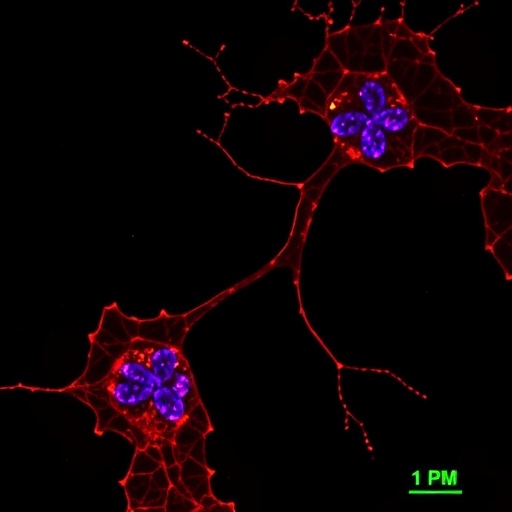In an era of rapidly evolving cancer therapies, the discovery of novel mechanisms driving tumor cell death offers a beacon of hope. Among these emerging modalities, “disulfidptosis” has captured the attention of scientists for its unique biochemical pathways and potential to reshape cancer treatment paradigms. A groundbreaking study published in BMC Cancer by Xu, Chen, and colleagues has meticulously charted the complex relationship between disulfidptosis and the tumor microenvironment (TME) across multiple cancer types, revealing profound prognostic implications and therapeutic opportunities.
Disulfidptosis constitutes a distinct form of regulated cell death, fundamentally different from apoptosis, necroptosis, or ferroptosis, distinguished by its reliance on intracellular disulfide bond dynamics. This pathway involves aberrant disulfide bond formation leading to cellular collapse and death, a process intricately tied to redox imbalances within tumor cells. The study’s comprehensive scope addresses a vital knowledge gap, providing the first pan-cancer exploration of genes related to this novel death mechanism, referred to collectively as disulfidptosis-related genes (DRGs).
Utilizing data from The Cancer Genome Atlas (TCGA), the research team implemented an integrative multi-omics approach to unravel the alterations in DRGs at genomic and epigenetic levels. They detected significant variations in gene expression patterns, copy number alterations, and DNA methylation profiles, which collectively influence how tumor cells regulate disulfidptosis. These molecular disruptions were not uniform but displayed pronounced heterogeneity across cancer types, underscoring the complexity of disulfidptosis regulation in distinct tumor contexts.
Central to this investigation was the construction of a disulfidptosis-related signature (DFRS), derived from advanced LASSO regression modeling combined with multivariate Cox proportional hazards analysis. This signature encapsulates the prognostic power of DRGs, stratifying patients according to risk and survival outcomes with remarkable precision. A high DFRS score consistently correlated with poorer prognosis, emphasizing its potential as a robust biomarker for clinical decision-making.
Beyond prognostication, the DFRS demonstrated a striking association with the tumor immune microenvironment. Tumors with elevated DFRS scores exhibited distinct immune infiltration patterns, characterized by an immunosuppressive milieu that likely impedes effective anti-tumor immunity. This intricate interplay suggests that disulfidptosis not only shapes tumor cell fate but also modulates the surrounding immune landscape, influencing tumor progression and resistance to immunotherapies.
Intriguingly, the study highlights the predictive capacity of the DFRS concerning therapeutic responsiveness. Patients exhibiting higher DFRS scores showed differential sensitivity to immune checkpoint inhibitors and conventional treatments, raising the prospect of utilizing disulfidptosis-related markers to personalize therapy. This aligns with a growing trend in oncology, where molecular signatures guide the selection and optimization of therapeutic regimens.
At the signaling level, disulfidptosis intersects with pivotal oncogenic pathways, including PI3K/AKT, MAPK, and p53 networks. Such crosstalk consolidates the role of disulfidptosis in tumor biology, integrating metabolic stress responses with cell death machinery. Targeting these interconnected pathways could potentiate the induction of disulfidptosis in resistant cancer cells, thereby overcoming therapeutic resistance.
The research further delves into epigenetic landscapes, revealing how DNA methylation patterns in DRGs modulate their expression and, consequently, disulfidptosis susceptibility. Aberrant methylation commonly silences tumor suppressor genes, but in the context of DRGs, it may either promote or inhibit the cell death pathway depending on specific gene targets. This nuanced epigenetic regulation opens avenues for demethylating agents or other epigenetic therapies to restore disulfidptosis in malignancies.
Importantly, the authors profile the heterogeneity of the TME across tumor types and correlate it with disulfidptosis dynamics. The TME encompasses not only immune cells but also fibroblasts, extracellular matrix, and vascular components, all of which orchestrate tumor progression. Understanding how disulfidptosis-related processes reshape this environment offers a holistic view of tumor ecology and potential vulnerabilities.
The study’s methodological rigor stands out, integrating large-scale genomic data with sophisticated bioinformatic models to yield actionable insights. This approach exemplifies the power of systems biology to dissect complex cancer phenotypes and identify convergent vulnerabilities amenable to therapeutic exploitation. By placing disulfidptosis at the crossroads of cancer genomics, immunology, and therapy, the research paves the way for innovative treatment strategies.
From a translational perspective, these findings suggest that modulating disulfidptosis could complement existing therapies such as checkpoint blockade and targeted kinase inhibitors. Pharmacologic agents designed to enhance disulfidptosis or to circumvent resistance mechanisms hold promise to improve patient outcomes, particularly for tumors with traditionally poor prognosis.
Moreover, the identification of DRG expression patterns as biomarkers enables early stratification of patients, facilitating timely intervention and personalized care. Precision oncology’s future increasingly relies on multifaceted signatures like DFRS to decode tumor behavior and predict therapeutic success.
The implications extend beyond prognosis and therapy. By elucidating the biology of disulfidptosis, the study contributes fundamentally to cell death research, expanding the repertoire of regulated death modalities and their relevance in human disease. This foundational knowledge is essential for conceptualizing novel drug targets and understanding cancer cell vulnerabilities.
Notably, the authors emphasize the necessity of further experimental validation and clinical trials to translate these discoveries into clinical practice. The interplay between disulfidptosis and the TME is undeniably complex, warranting in-depth mechanistic studies and the development of reliable assays for clinical monitoring.
In summary, this landmark research underscores disulfidptosis as a pivotal mechanism in cancer pathophysiology, intimately linked to the tumor microenvironment, patient prognosis, and therapeutic response. By harnessing its potential, future oncology treatments may achieve higher specificity and efficacy, marking a paradigm shift in how we approach cancer management globally.
As the oncology community continues to unravel the intricacies of tumor biology, disulfidptosis emerges as a critical frontier, promising to refine our understanding and treatment of cancer in the years to come.
Subject of Research: Disulfidptosis and its interaction with the tumor microenvironment across multiple types of cancer, focusing on prognosis and therapeutic response.
Article Title: Interplay of disulfidptosis and the tumor microenvironment across cancers: implications for prognosis and therapeutic responses
Article References:
Xu, S., Chen, Z., Chen, X. et al. Interplay of disulfidptosis and the tumor microenvironment across cancers: implications for prognosis and therapeutic responses. BMC Cancer 25, 1113 (2025). https://doi.org/10.1186/s12885-025-14246-1
Image Credits: Scienmag.com




